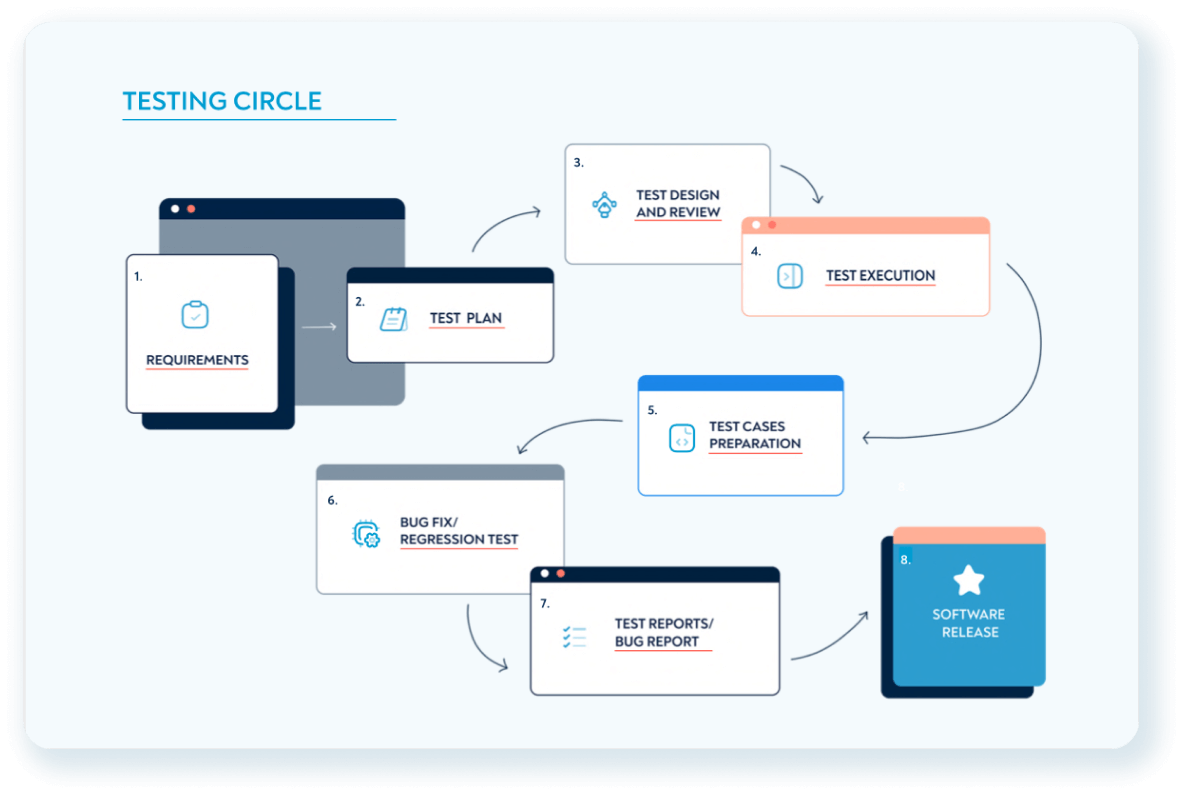What are the benefits of software development?
The benefits of software development testing go well beyond improved efficiency and decision-making. Quality assurance can also improve organisational effectiveness and strengthen teams, generating financial growth for companies. But does it mean that the presence of QA itself can enhance the entire work environment for your team or not? Our answer is no — just having it doesn’t mean better efficiency by default. Software testing process optimisation should be one of the priorities in the company on the way to reaching the business-oriented goals we described above.
Managing the testing process can be exhausting. However, we can give a piece of advice on how to exercise testing process optimisation. Here are our seven secrets:
What is a test management process?
Test management is the process of overseeing and controlling all of the testing activities within a project. It’s the backbone of successful software development; as William E. Lewis notes, “Effective test management is the linchpin of successful software development.”
It’s not just about executing tests; it’s about strategising, planning, and adapting. In fact, studies show that up to 30% of a project’s effort is dedicated solely to testing.
Managing your test process is tricky: you can’t wing it with a rigid checklist anymore. Start by ranking what could actually break your business (not just what’s technically complex), then drag developers and product folks into planning sessions from day one.
Your test plan should feel more like a Google Doc than a stone tablet – constantly updated as requirements shift. Establish a weekly 15-minute sync to reassess priorities based on recent changes. This way, you’ll avoid that classic trap of over-testing low-risk features while missing the stuff that actually matters to users. Communication is key—keeping everyone in the loop ensures smoother execution and quicker issue resolution. Remember, testing is more than just about finding bugs; it’s about ensuring the final product meets user expectations and quality standards.

Making the Most of Test Management Tool
Modern development moves quickly, and you need robust test management tools to keep up. Platforms like aqua cloud, or BrowserStack Test Management become your central hub for storing, organising, and tracking everything from test cases to defects in real time.
Pick one tool and migrate your most critical test suite first, rather than trying to move everything at once. This approach lets teams see nearly immediate improvements in collaboration while maintaining clear traceability from requirements straight through to release. The real win?
Automated reporting through customisable dashboards gives everyone – developers, QA, business analysts – instant visibility into quality metrics. When you integrate with your CI/CD pipeline, results update automatically without anyone lifting a finger. Having centralised test data actually speeds up root cause analysis by roughly 40%, since you’re not hunting through scattered spreadsheets and emails anymore.
Planning and Workflow
A confident and determined plan can navigate your team through the whole testing cycle mitigating risks or blurring the final goal. Test planning should include the objectives of necessary tests and a schedule for teams’ test activities to keep identified time frames and assigned roles and tasks to ensure that everyone understands their assignments. Simultaneously, the structured workflow helps your team visualise the process — where you start, what steps you take, and see the final output of all your test efforts.
The implementation of testing workflow managing frequently leads to improved collaboration.

Structured documentation
Documentation helps companies in the long perspective save cost and time on training, onboarding and delegation of upgoing projects to new employees. Another necessity of having documentation is to prevent issues caused by lacking testing or development documentation. Better structured documentation brings more efficiency to your testing process without scattering unnecessary actions.
Quality metrics
Clear metrics and benchmarks give you a better understanding of how well your QA processes are managed. Comprehensive test reporting can help determine which metrics to consider and which can be omitted as part of test management. For instance, in aqua cloud, it is possible to compare different metrics in different scenarios, while some test management tools provide only standard report templates. However, if you don’t use them, then you can enter metrics based on your own needs, e.g. rate of delivery, security, reliability, maintainability, and performance efficiency.

Automation optimisation
You can endlessly sing the praises of test automation, and still, it will not be enough. Automation is getting better and more efficient every year, tests are more accurate, and the presence of machine learning elements allows you to expand the possibilities of such testing to the point of being backless. It is clear that even small enterprises with a couple of testers on staff sooner or later come to automation. Using a simple web automated testing tool can be a significant breakthrough towards efficiency.
Acceptance testing
More often than not, novice testers follow standard test scenarios and sometimes rely on them too much. Unfortunately, it is impossible to predict all scenarios, and this leads to the fact that bugs remain in the code. Therefore, involving end-users in the final stage of development can be crucial for the product’s release. This not only helps to identify defects but also to create new templates for test scenarios.
Among other things, acceptance testing helps determine how your product meets the requirements of regulators. Having test management software for regulated industries in your QA management can also contribute to regulatory compliance.
Zero-tolerance to disrespect
Delegate, involve, respect and distribute — these four words perfectly describe the approach to improving the working environment. A relaxed work environment helps enhance the quality of life of employees and significantly improves your QA. Involving testers in work outside of their occupation helps them feel their importance to the company.
Respecting the QA team reduces the risk of missing bugs in the code, as testers are more meticulous about business. Moreover, the proper distribution of roles and tasks — then everyone knows their area of responsibility and can guarantee the result.
Switching to a shift-left approach
Last but not least, we’ve put on a shift-left approach. Introducing QA in the early stages of development significantly reduces the cost of fixing bugs if they are discovered later. It also helps track common mistakes that are repeated from project to project and prevent their occurrence in the future. This approach should also include more frequent testing, regular requirements reviews, encouraging communication between departments, and process automation.

Why is test management important?
What’s the importance of test management in the grand software development scheme?
Test management is the backbone of QA, providing a structured framework to oversee, organise, and execute testing processes within a project. With strong management, you ensure a systematic approach to identifying defects, assessing risks, and validating the functionality of software products. If you neglect this organised oversight and allow chaos in the process, the likelihood of missing critical issues increases, potentially leading to software failure upon deployment.
To manage the test process effectively, you must strategically orchestrate the entire testing phase. It helps maintain quality standards, meet user requirements, and deliver a robust, reliable product. By having a well-managed testing process, you can track progress, identify bottlenecks, and make informed decisions to mitigate risks, ultimately contributing to the success of the overall development lifecycle.
Continuous Improvement and Retrospectives
Your software quality journey doesn’t stop at release; that’s actually where the real learning begins. Smart teams wrap up each testing cycle with honest retrospectives, digging into what worked and what didn’t. You’ll want to track which bugs escaped detection, where your process hit roadblocks, and how testing decisions affected business outcomes.
Create a simple spreadsheet tracking defect sources and resolution times for your next three sprints. Teams using this approach see their bug escape rates drop by nearly half within six months. But here is the thing: Continuous improvement isn’t just tweaking test cases. You’re building a feedback loop that keeps pace with changing requirements and tech stacks. This habit makes your team more confident in their decisions and faster at delivering quality products.
Conclusion
Managing the testing workflow is a very individual instance for companies. There can be no universal tips on whether all seven listed secrets will work or only one. Anyway, your test management will only be effective if you build it on your company’s needs and apply advanced management methods. However, these seven ways to improve your test management are today’s most popular and in-demand methods.
To sum it up, with proper management of test processes in place, QA teams can perform tasks with more confidence and pride and, as a result, collaborate more effectively.

















